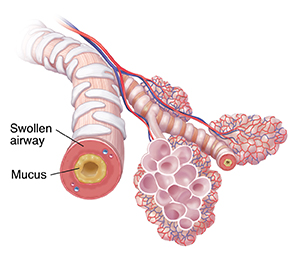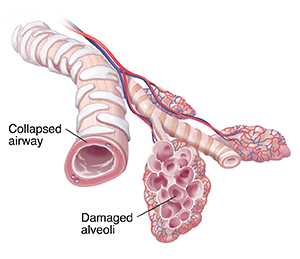COPD: Wheezing and Chest Tightness
When you have COPD, wheezing, shortness of breath, and chest tightness are common symptoms. Wheezing is a whistling or squeaking sound when you breathe in or out. Chest tightness may feel like it is hard to take a deep breath or it's painful to breathe. It can cause a feeling of shortness of breath.
How does COPD cause wheezing and chest tightness?
COPD is a condition that keeps your lungs from working as they should. The lungs’ job is to get air in and out of the body. Inside the lungs, air moves through tubes called airways. In healthy airways, air moves in and out easily. With COPD, lungs and airways become damaged. This damage causes the lining of airways to swell and become clogged with mucus. The airways can also collapse. Then air does not move in and out of the body normally. This can lead to wheezing and chest tightness.
COPD is a term for two main conditions. These are chronic bronchitis and emphysema. In both of these conditions, the airways and lungs become damaged. The damage is usually due to breathing in irritants over a long period of time. The main irritant that causes COPD is cigarette smoke. Other irritants are pollution, dust, fumes, and chemicals.
With chronic bronchitis, the damaged airways make more mucus than normal. Mucus is a thick, sticky fluid. It traps smoke and other harmful irritants breathed in. This helps protect the airways. But too much mucus can make the airways narrow. Bronchitis can also cause the airways to swell. The muscles that surround the airways may tighten. These problems cause the airways to narrow even more. This means less air moves in and out of the lungs.
Air contains oxygen. This is an important gas the body needs to function properly. In healthy lungs, air moves to the air sacs (alveoli). These are bunches of round sacs at the end of the airways. Oxygen passes from the air sacs into the bloodstream. Then it is carried to the rest of the body. As the body uses oxygen, a gas called carbon dioxide is produced. This gas goes back to the air sacs. Then it is breathed out of the body. This process is called gas exchange.
With emphysema, gas exchange does not work well. This is because the air sacs become damaged. The airways are also damaged. They are not as stretchy as they should be. They become floppy and may collapse when you breathe out. This traps stale air in the air sacs. Then not as much fresh air can be breathed in. This makes it harder to take a deep breath.
 |
| Airway with chronic bronchitis. |
 |
| Airway with emphysema. |
Treatment for wheezing and chest tightness
There is no cure for COPD other than lung transplant. But certain treatments can help wheezing and chest tightness:
-
Bronchodilators. These medicines help open the airways to improve breathing.
-
Combination medicines. These include a bronchodilator and a steroid. Steroids help keep the lining of the airways from getting swollen or inflamed. This helps reduce swelling and mucus production.
-
Antibiotics. A respiratory infection can make COPD symptoms worse. Antibiotics are medicines that help treat infections.
-
Pulmonary rehab (rehabilitation). This program teaches ways to ease COPD symptoms. It includes tips on exercising, correct posture, how to conserve energy, and eating healthy to improve breathing.
-
Oxygen therapy. When the level of oxygen in the blood is too low, your healthcare provider may prescribe oxygen therapy. Or, when lungs can’t get enough oxygen to the blood, you may get extra oxygen. Oxygen can be used some of the time or most of the time. Talk with your healthcare provider about when you should use the oxygen therapy.
-
Surgery. This may be done for severe symptoms when other treatments have not helped. Surgery removes the most damaged parts of the lungs.
Your healthcare provider will work with you to decide on the best treatment for you.
Self-care tips for wheezing and chest tightness
There are ways you can get relief from your COPD symptoms:
-
Stop smoking. Cigarette smoking is the main cause of COPD. Stopping smoking is the most important step you can take to treat COPD. If you need help stopping smoking, talk with your healthcare provider.
-
Stay away from secondhand smoke and other irritants. Try to stay away from smoke, chemicals, fumes, and dust. Don’t let anyone smoke in your home or around you. Stay indoors on smoggy days.
-
Prevent lung infections. Get vaccines as directed by your provider. Having COPD increases your risk for flu and pneumonia. Ask your healthcare provider about the flu and pneumonia vaccines. Take steps to prevent colds and other lung infections. Stay away from crowds during cold and flu season, and avoid others who are sick.
-
Practice correct handwashing. This helps prevent infections. Wash your hands often with soap and water for at least 20 seconds. Use hand sanitizer with at least 60% alcohol when you can’t wash your hands.
-
Do breathing exercises. Learn how to do belly breathing and pursed-lip breathing. These two exercises can help you breathe better. Try to do each exercise for 5 to 10 minutes every day or as recommended.
-
Don’t be afraid to be active. Being active may make you short of breath. Exercise can strengthen the muscles that help you breathe. Ask your healthcare provider about safe exercises. They will help you find a routine that's right for you.
-
Eat small meals throughout the day. Your stomach won’t get as full. Then your lungs will have more room to expand.
-
Drink plenty of water. This can make mucus thinner and easier to cough up. Ask your healthcare provider how much water you should drink.
-
Talk to your healthcare team about your mental health. Shortness of breath can cause anxiety. And anxiety can make you breathe faster, which makes shortness of breath worse. Your healthcare provider can suggest options for treating anxiety, panic attacks, and other mental health concerns.
When to call your healthcare provider
Call your healthcare provider or seek medical care right away if you have any of these problems:
-
Fever of 100.4°F (38°C) or higher, or as directed by your healthcare provider
-
Symptoms that don’t get better, or get worse
-
New symptoms